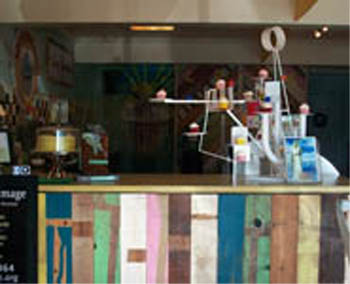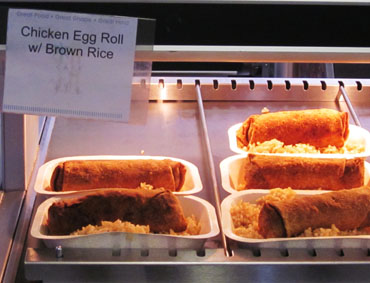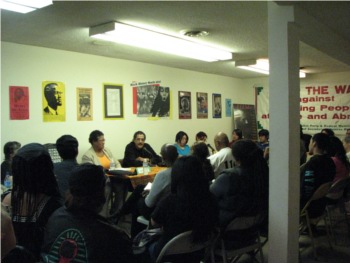Listen to a story from Annenberg Radio News
 When you walk through the doors at Lucy Florence Cultural Center, you are taken aback by the bright colors and elegant decorations. There’s a coffee bar to grab a bite to eat. The hallway leads to hidden rooms filled with artistic treasures. There’s even a room with a stage, piano and rows of seats to put on a good show.
When you walk through the doors at Lucy Florence Cultural Center, you are taken aback by the bright colors and elegant decorations. There’s a coffee bar to grab a bite to eat. The hallway leads to hidden rooms filled with artistic treasures. There’s even a room with a stage, piano and rows of seats to put on a good show.
It’s a place for the people of Leimert Park to collaborate and bring together the cultural, political, talent and economic values of the village.
“This place, Lucy Florence Coffee House and Cultural Center, is one of the things that holds it in,” said a woman who frequents the coffee shop. “You know, one of the anchors of the village.”
As loved as Lucy Florence is, it still hasn’t brought a lot of foot traffic. The center is owned by twin brothers Rich and Bob Harris. Rich says they have to close up as early as May because they’re having trouble coming up with the rent money.
“We are desperately gathering up money to pay a financial emergency here at Lucy Florence,” Rich said.
The brothers recently returned, back from visiting their home city, Atlanta, where Rich says all businesses in the African American community flourish and attract people of all backgrounds. They believe Lucy Florence can do the same.
“We want that type of feel to create itself in a community that has often way before we became a part of it is labored as the last and only cultural participation in Los Angeles,” Rich said.
As a way of encouraging people to come into the store, they’ve been offering a 50 percent off sale, but right now, the center still stands as an important place. One woman came today because she wants to support the family-like atmosphere.
“You don’t have to come in and buy anything,” she said. “You come in and sit down and have a cup of tea, you know, and you can partake in all the art that’s in here because there’s a lot of culture in this building.”
Even though you don’t have to buy anything, the Harris brothers are hoping you do. If the Lucy Florence Cultural Center can bring in more business, it will have a chance to survive and serve the community.
The following is a letter from the owners of Lucy Florence Cultural Center
 We are in a season of resurrection. The photo was taken on Easter 1961; a past season of resurrection. We stood before our twin sisters with no knowledge of the many rebirths we would experience during this lifetime. We were young, protected, loved and unafraid. We stood before our twin sisters knowing nothing about the wonderful adventures in our future. That was 50 years ago. Today, we are living proof of the Divine MotherFatherGod and the spirit of resurrection. We embrace countless lessons about life, death, fear and achievement along the way. We are boys, students, men, teachers, retail buyers, managers, dancers, coaches, designers, owners and creators. We’ve died and been reborn so many times we’ve lost count of our birthdays! This is a season of resurrection; but is it our season of resurrection?
We are in a season of resurrection. The photo was taken on Easter 1961; a past season of resurrection. We stood before our twin sisters with no knowledge of the many rebirths we would experience during this lifetime. We were young, protected, loved and unafraid. We stood before our twin sisters knowing nothing about the wonderful adventures in our future. That was 50 years ago. Today, we are living proof of the Divine MotherFatherGod and the spirit of resurrection. We embrace countless lessons about life, death, fear and achievement along the way. We are boys, students, men, teachers, retail buyers, managers, dancers, coaches, designers, owners and creators. We’ve died and been reborn so many times we’ve lost count of our birthdays! This is a season of resurrection; but is it our season of resurrection?
We’ve lived in Los Angeles for nearly 30 years and it’s our second home. Last week, we visited the original Lucy Florence (our mother) in our hometown of Atlanta, Georgia. Absence makes for interesting insight. We forgot how different things can be from city to city.
Small business is thriving in the ATL. Surprisingly, we saw no invisible racial borders when it came to commerce. Money changed hands among, between, within and across ethnicities. Businesses were packed with people of different races. There was no ‘Hollywood’ expectation of free services to boast celebrity patrons. People didn’t act like anyone “owed” them anything beyond the good or service for which they paid. Everyone pays and everyone benefits. Don’t be mistaken, though. There was no chorus of Kumbaya, just a respectable exchange of currency for quality goods and services. You know, business.
During our absence, we closed our doors because … well … staffing is expensive when business is slow. We returned to concerned voicemail messages (and perhaps a few nosy-bodies) asking if we were closed for good. People shouted from car windows shoutins, “we hope you guys aren’t closing?” But they didn’t stop conduct any business.
Businesses are failing all around us. Other groups are closing ranks and going into survival mode, while our community dollars are spread about like discarded candy wrappers. Spending dollars close to home matters – it matters to us and it matters to you. This is about more than keeping a business open; it’s about quality of life in your community. It’s about maintaining property values and creating a supportive economy and healthy tax-base in your own neighborhood. It’s about stepping up to the plate and spending money where you live to enhance your own standard of living.
Ongoing complaints about metered parking in Leimert Park are futile. Paid parking is the norm in other shopping areas around Los Angeles (Santa Monica, Culver City, Beverly Hills, Westwood, Hollywood, Inglewood, Hawthorne, Downtown). Why not in Leimert Park? This is not a reason, it is an excuse. What can you do? Make a shift in your fiscal consciousness. Every dollar counts. It’s time for common sense consumerism.
Buy from your customers. When someone patronizes you, patronize them. If Lucy Florence purchases your cakes, pies, beverages, gift items, clothing or jewelry, return the favor by making a purchase when you deliver the order. Reciprocity is the Golden Rule.
Support those who support you. When you leave flyers, postcards and announcements at a place of business, buy something. Do your part to pump blood through your own vein of low-cost PR and advertising.
Support Leimert Park Village for preservation of African American culture. Shop at Eso Won Books. You’ll be impressed with their lineup of booksignings and lectures. For unique handmade jewelry and gift items, check out Sika Dwimfo and our women-friends at Zambezi Bazaar. Gallery Plus is well known for African American artwork, hand crafted dolls and other collectibles. KAOS Network owner and filmmaker, Ben Caldwell, provides a rich and diverse experience for creatives with his Leimert Park Art Walk. For women’s clothing, cards, gifts and jewelry, make Lucy Florence your first stop. Looking for lovely home and garden decorations? Come to Cultural Interiors inside Lucy Florence. Need to relax, unwind and feed your soul? Looking for answers to questions about life, career and romance? WU Wellness Loft inside Lucy Florence offers Reiki, crystal therapy, polarity therapy, massage and readings. Looking for a fun place to learn something new or to host your workshop? Call Lucy Florence for rentals or attend a workshop.
Thank you all for making us feel appreciated. To answer the question, no. Lucy Florence is not closing. Not yet. But if another resurrection is in our future, we are ready and willing to do it again if that is our calling. And when we rise, we will soar again because potentiality and possibility are endless gifts from God. Perhaps we will see you at the (other) top, where we will laugh and talk about the wonderful business we transacted to our mutual benefit. But only if that is the truth. In the meantime, let’s celebrate and be held accountable to one another for the success of our businesses and local economy. Happy Resurrection Day, everyone.
Fondly,
Ron and Richard Harris

SHOW YOUR SUPPORT NOW
Lucy Florence Cultural Center has been a part of the Historic Leimert Park Village for 10+ years. We have opened our doors to communty theater groups and professionals. We helped launch the careers of entertainment greats like Tyra Banks and Macy Gray. We’ve been a safe place for latchkey children and a training ground for young college students to gain valuable work experience. Lucy Florence is home to independent business owners and vendors who need to work in partnership to survive these tough times. We are an affordable and lovely meeting place for local clubs, groups, associations, and organizations. We are a space to celebrate births at parties and mourn deaths with repasts. In short, we are proactive community contributors and activists. Now we need immediate support from the community.
Here’s How You Can Help
(1) Show your support in dollars and cents. Shop at Lucy Florence this April 18th & 19th and save up to 50%.
(2) Show your support by referring others. Forward this to your email distribution list and ask your friends and associates to shop at Lucy Florence on April 18th & 19th.









 When the 1 p.m. bell rang at Manual Arts High School, the students fled to the cafeteria for lunch. As the line lengthened, students carried small Styrofoam trays toward shelves of food.
When the 1 p.m. bell rang at Manual Arts High School, the students fled to the cafeteria for lunch. As the line lengthened, students carried small Styrofoam trays toward shelves of food.  In 2004, the school board passed the Childhood Obesity Prevention Motion; in 2005, it launched the Cafeteria Reform Motion. Both motions set strict guidelines on what kind of food can be served in schools based on calorie count. They also reduce levels of sugar, sodium, and saturated fat and eliminating trans fat and palm oil in menu items and junk food and soda sales.
In 2004, the school board passed the Childhood Obesity Prevention Motion; in 2005, it launched the Cafeteria Reform Motion. Both motions set strict guidelines on what kind of food can be served in schools based on calorie count. They also reduce levels of sugar, sodium, and saturated fat and eliminating trans fat and palm oil in menu items and junk food and soda sales. Healthier Food, Healthier Students
Healthier Food, Healthier Students Ventura said that each cartoon of chocolate milk has two teaspoons of sugar. If a student drank two cartoons every school day, the student would consume 14 cups or roughly a gallon of pure sugar.
Ventura said that each cartoon of chocolate milk has two teaspoons of sugar. If a student drank two cartoons every school day, the student would consume 14 cups or roughly a gallon of pure sugar.  South Los Angeles community members gathered Thursday for a home-cooked meal and a thought-provoking discussion to debunk the myth of a post-racial society after the election of Barack Obama.
South Los Angeles community members gathered Thursday for a home-cooked meal and a thought-provoking discussion to debunk the myth of a post-racial society after the election of Barack Obama.




